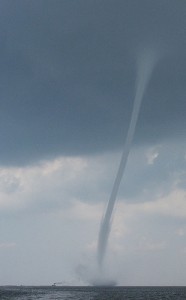
Waterspouts are recognizable by their attachment to clouds. Photo: Hanroanu (flickr)
The residents of Belgium Wis. were surprised to see what they thought to be a winter waterspout recently in Lake Michigan, but it turns out what they really saw was a steam devil.
The confusion is understandable. Steam devils and waterspouts are both created by sea smoke, very cold air moving across warmer waters evaporating so fast they produce vapor. But steam devils are formed in open air while waterspouts attach to the clouds, said Wade Szilagyi director of the International Centre for Waterspout Research in Ontario.
People get steam devils and winter waterspouts mixed up quite often. Szilagyi said, “If you look closely you can see that the clouds are off in the distance and the steam devil is in the fore-ground.”
There were 186 reports of waterspouts on the Great Lakes in 2012 and that shattered the previous record set in 2003 of 94 spouts, Szilagyi said.
There are two reasons why 2012 was a record-breaking year, he said. One is the hot summer heating up the Great Lakes. Cooler air that started to roll in during August and September created outbreaks of waterspouts.
“The other factor is that it is becoming easier and easier to obtain reports of waterspouts through social media,” Szilagyi said.
“Waterspout formation typically occurs when cold air moves across the Great Lakes and results in large temperature differences between the warm water and the overriding cold air,” said Bruce Smith a meteorologist for the National Weather service in Gaylord Mich.
There are two main types of waterspouts: fair weather and tornadic, he said.
A fair weather waterspout happens over open water and is rather small and brief. Tornadic waterspouts are larger and are generally tornadoes produced by a thunderstorm, Smith said.
“Eighty-three percent of the waterspouts seen are fair weather and the other 17 percent seen are severe weather waterspouts,” Silagyi said.
Bob Hartig, a storm chaser from Grand Rapids for 15 years, has been chasing waterspouts for the past two. He said, the best time of day is the morning.
“In terms of daylight, early morning is a favored time for chasers to get out before the land breeze transitions to a lake breeze which moves convergence inland.”
Last September Hartig was at Tunnel Park in Holland Mich. when he shot this video (published here with permission) of his first waterspout and family of waterspouts.
The International Centre for Waterspout Research came up with a forecasting system called the Waterspout Nomogram which uses three things to forecast them. One is the temperature difference between the water and the air, another is cloud thickness over the water and another is wind speed, Szilagyi said.
The Waterspout Nomogram predicts waterspouts with numbers from minus 10 to plus 10. “For a value from zero or more there is a potential for waterspouts and anything that is less than zero waterspouts are not likely,” Szilagyi said.
Waterspouts are not very dangerous to people on land, but can be dangerous and harmful when on the water, Smith said.
The National Weather Service in Gaylord, wants boaters to take the watches and warnings seriously, he said. “We advise boaters to get to safe harbor when a Special Marine Warning is issued. When this can’t be done we suggest staying away from any storm type clouds that may produce waterspouts.”
Hartig recommends that if you see a waterspout to log on to the International Centre for Waterspout Research and report it. You should take video and pictures if you can, he said.
“The more such data that the ICWR receives, the more they can refine their waterspout forecasting maps,” he said.
Pingback: Lake Michigan Waterspouts Spotted Off The Coast Of Kenosha, Wisconsin (PHOTO, VIDEO) «